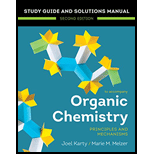
(a)
Interpretation:
A reasonable mechanism for the given pinacol rearrangement reaction is to be proposed.
Concept introduction:
The unimolecular elimination (
(b)
Interpretation:
The reason for the carbocation rearrangement for the given reaction is to be explained.
Concept introduction:
In the carbocation rearrangement, the carbocation gains significant stability from resonance delocalization of the charge. Resonance can provide substantial charge stability.
Want to see the full answer?
Check out a sample textbook solution
Chapter 8 Solutions
EBK ORGANIC CHEMISTRY: PRINCIPLES AND M
- The reaction shown here yields three different nucleophilic substitution products that are constitutional isomers of one another. (a) Does this suggest an SN1 or Sn2 mechanism? (b) Draw the mechanism for the formation of each of these products. CH3CH2OH Brarrow_forwardPlease provide a complete, detailed curved-arrow mechanism for the following reaction. Include ALL lone pairs and formal charges. Using the mechanism and a few words, explain why the NaOH deprotonates at the a-position and not the b-position or the aldehyde hydrogen. Also, explain why the indicated alkene is formed in the 2nd second rather than the other possible alkene product.arrow_forward(a) Determine all possible products from the following reaction. Also, identify the products as kinetic or thermodynamic products. (b) Also draw a detailed mechanism for the formation of these products. H-CIarrow_forward
- (a) Propose a mechanism for reaction A, which is a substitution reaction. (b) Explain why reaction B does not lead to a similar substitution.arrow_forward4) Draw the complete electron-pushing arrow mechanism for the following reductions. Explain, using resonance contributors, the regiochemistry that results in each case. ỌMe Na, MeOH ? NH3 CHO Na, MeOH ? NH3arrow_forwardProvide the mechanism and the structure of the products A and B in the given reactions. Explain the advantage of one over the other.arrow_forward
- Please provide a complete, detailed curved-arrow mechanism for the following reaction.Include ALL lone pairs and formal charges. Using the mechanism and a few words,explain the why the NaH deprotonates at the selected a-position and not the other a-position. Also explain why the indicated alkene is formed in the 3rd step rather than the other possible alkene product.arrow_forward(a) Identify the major product of the following reaction. (b) Explain why the other product is not the major product.arrow_forward18.56 Predict the major organic product and draw the complete, detailed mechanism for each of the following reactions. (a) (b) OH OH (c) HO ? OH HO ? HO HO OH HO ?arrow_forward
- (1) Identify the nucleophile and electrophile for each step (2) Provide the mechanism using curved arrows (3) Then identify which elementary step it isarrow_forwardDraw the complete, detailed mechanism for each of the following reactions and predict the major product. NaOEt? (a) Ethyl 3-methylbutanoate ETOH NaOEt (b) Ethyl propanoate + Ethyl benzoate ? ELOH NaOEt (c) Ethyl butanoate + Diethyl carbonate ? ETOHarrow_forward(A) Which is an alkyl iodide that will give SN1 and E1 product? (B) Which is most likely to give rearrangement product in SN1?arrow_forward
 ChemistryChemistryISBN:9781305957404Author:Steven S. Zumdahl, Susan A. Zumdahl, Donald J. DeCostePublisher:Cengage Learning
ChemistryChemistryISBN:9781305957404Author:Steven S. Zumdahl, Susan A. Zumdahl, Donald J. DeCostePublisher:Cengage Learning ChemistryChemistryISBN:9781259911156Author:Raymond Chang Dr., Jason Overby ProfessorPublisher:McGraw-Hill Education
ChemistryChemistryISBN:9781259911156Author:Raymond Chang Dr., Jason Overby ProfessorPublisher:McGraw-Hill Education Principles of Instrumental AnalysisChemistryISBN:9781305577213Author:Douglas A. Skoog, F. James Holler, Stanley R. CrouchPublisher:Cengage Learning
Principles of Instrumental AnalysisChemistryISBN:9781305577213Author:Douglas A. Skoog, F. James Holler, Stanley R. CrouchPublisher:Cengage Learning Organic ChemistryChemistryISBN:9780078021558Author:Janice Gorzynski Smith Dr.Publisher:McGraw-Hill Education
Organic ChemistryChemistryISBN:9780078021558Author:Janice Gorzynski Smith Dr.Publisher:McGraw-Hill Education Chemistry: Principles and ReactionsChemistryISBN:9781305079373Author:William L. Masterton, Cecile N. HurleyPublisher:Cengage Learning
Chemistry: Principles and ReactionsChemistryISBN:9781305079373Author:William L. Masterton, Cecile N. HurleyPublisher:Cengage Learning Elementary Principles of Chemical Processes, Bind...ChemistryISBN:9781118431221Author:Richard M. Felder, Ronald W. Rousseau, Lisa G. BullardPublisher:WILEY
Elementary Principles of Chemical Processes, Bind...ChemistryISBN:9781118431221Author:Richard M. Felder, Ronald W. Rousseau, Lisa G. BullardPublisher:WILEY





